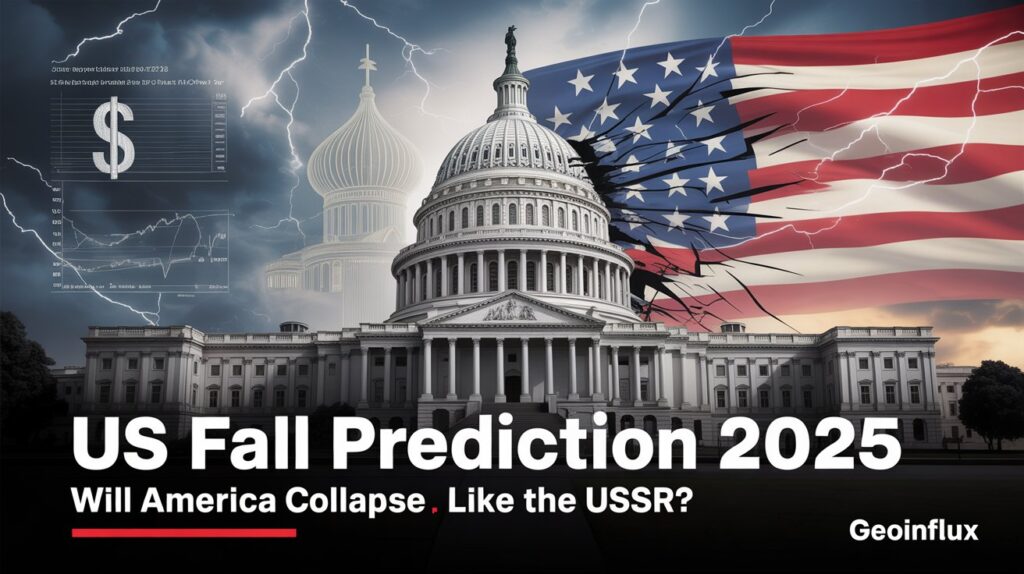The US fall prediction raises questions about America’s stability. Could the U.S. face a Soviet-style collapse? Explore the economic, political, and geopolitical risks here.
What is the US fall prediction 2025?
The US fall prediction 2025 suggests that America may face a decline similar to the Soviet Union’s collapse in 1991. Analysts point to rising debt, political polarization, and global power shifts as warning signs. While the U.S. remains a global leader, its structural challenges raise questions about long-term stability.
Also Read: US Politics
How does the US fall prediction compare to the USSR’s collapse?
The Soviet Union collapsed due to economic stagnation, propaganda control, and loss of public trust. The US fall prediction 2025 draws parallels: massive debt, declining public faith in institutions, and fragmented information ecosystems. However, unlike the USSR, America still commands global financial leverage through the dollar and remains technologically dominant.
What global power shifts challenge US dominance in 2025?
China’s economic rise and India’s growing influence are reshaping global geopolitics. The US fall prediction 2025 often highlights BRICS expansion, energy trade in non-dollar currencies, and Russia’s pivot to Asia as factors weakening U.S. leverage. As multipolarity strengthens, America faces the same problem the USSR did—overstretching abroad while facing domestic discontent.
How does the US military-industrial complex link to the US fall prediction 2025?
The U.S. military-industrial complex wields enormous influence over policy. Trillions spent on foreign wars have deepened domestic economic pressures. This mirrors the Soviet model, where military overspending drained resources from citizens. Critics argue that the US fall prediction 2025 is reinforced by the risk of repeating this cycle—prioritizing global dominance over internal stability.
Also Read
Most Popular
How does the media and information bubble affect the US fall prediction?
The USSR controlled narratives through Pravda. In contrast, the U.S. suffers from fragmented media, where partisan outlets and social media create echo chambers. This information chaos fuels polarization and undermines trust. Analysts argue the USA fall prediction is partly rooted in this fractured information ecosystem that destabilizes governance.
What economic warning signs exist in the US fall prediction 2025?
The USA fall prediction 2025 draws on key economic risks:
- National debt exceeding $34 trillion
- Persistent inflation and layoffs in the tech sector
- Declining global confidence in the dollar’s supremacy
These signs echo late-Soviet economic decline. Yet, unlike the USSR, America benefits from its role as the issuer of the world’s reserve currency, which may delay collapse.
Are lessons from the Soviet collapse being ignored in the US fall prediction?
Key Soviet-era warning signs include elite corruption, public disillusionment, and failure to reform. In the U.S., rising inequality, lobby-driven governance, and disconnect between leaders and citizens raise similar alarms. The prediction highlights how Washington may be ignoring critical lessons from Moscow’s downfall.
What do analysts say about the US fall prediction?
Experts are divided. Some argue that U.S. resilience, technological innovation, and alliances make collapse unlikely. Others stress that overconfidence may blind Washington to systemic risks. Indian and Russian analysts, in particular, highlight how multipolarity is eroding U.S. dominance faster than expected, adding weight to the USA fall prediction debate.
What are the key takeaways from the US fall prediction debate?
The US fall prediction 2025 does not mean America is on the verge of an immediate Soviet-style collapse, but warning signs exist: economic fragility, political polarization, and declining global dominance. The world is shifting toward multipolarity, and America’s ability to adapt will determine its future. Collapse is not inevitable, but neither is stability guaranteed.
Recap Table: How Does the US Compare to the USSR?
| Factor | USSR Pre-1991 | USA in 2025 |
|---|---|---|
| Economy | Stagnation, debt, shortages | High debt, inflation, layoffs |
| Military | Overspending on arms | Trillions spent on wars |
| Politics | Leadership crisis | Polarization, weak governance |
| Media | State propaganda | Fragmented, polarized media |
| Global Role | Declining influence | Facing multipolar competition |
FAQs
What are the main signs in the US fall prediction 2025?
The US fall prediction 2025 highlights national debt, political instability, inflation, and weakening global influence. Social divisions and declining trust in institutions further signal systemic risks that resemble Soviet decline.
How did the USSR’s collapse impact the US fall prediction narrative?
The Soviet collapse ended the Cold War and left the U.S. as the sole superpower. Analysts use that history to frame the US fall prediction 2025, suggesting a similar geopolitical reset could occur if America weakens further.
Could the US really collapse as predicted in the US fall prediction 2025?
While the U.S. has more financial resilience than the USSR, structural risks remain. Failure to reform its political system, reduce debt, and rebuild trust could push it toward instability, giving weight to the prediction.
What do experts forecast about the US fall prediction?
Some predict a slow decline rather than a sudden collapse. Multipolarity led by China, India, and BRICS is eroding U.S. dominance. Yet many believe America will remain a top-tier power, even if the US fall prediction 2025 proves partially accurate.
How important is the dollar in the US fall prediction 2025?
The dollar remains the backbone of global trade and finance. Its dominance allows the U.S. to sustain debt levels that would cripple other nations. Analysts argue that if the dollar loses reserve status, the US fall prediction could accelerate dramatically.
Related Articles
- India and the QUAD: Balancing China Without Burning Bridges
- Is the American Century Over? The Rise of Multipolar Geopolitics
- Lessons from the USSR: Can the US Avoid a Superpower’s Fate?
References: What Are the Sources of This Analysis?
- RAND Corporation – US decline vs resilience studies
- Carnegie Endowment – multipolar world analysis
- The Economist – US economy 2025 forecasts
- Foreign Affairs – America’s role in global order
- Al Jazeera – Global perspectives on US decline
- Reuters – US economic and political instability
- The Hindu – Multipolar world coverage

